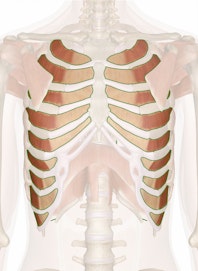The Intercostal Muscles
Explore the anatomy and function of the intercostal muscles with Innerbody's interactive 3D model.

The intercostal muscles are a group of 22 pairs of tiny muscles found between the ribs. These muscles play a vital role in the movement of the chest during breathing. They also help to solidify the thoracic region and protect the lungs.
Anatomy
The 22 pairs of intercostal muscles are broken down into two groups: 11 pairs of internal intercostals and 11 pairs of external intercostals. Each rib is connected to the rib below it by both an external and internal intercostal muscle. The twelfth rib is the exception as it is the inferior-most rib.
The external intercostal muscles are the more superficial of the two groups. Their origins are along the inferior borders of the first 11 ribs and their insertions are along the superior borders of the rib below. The fibers of the external intercostals run obliquely inferior and anterior to the origin. Contraction of the external intercostal muscles elevates the ribs and spreads them apart.
The internal intercostal muscles are the deeper set of intercostal muscles. Their origins form along the superior border of the second through twelfth ribs and their insertions form along the inferior borders of the rib above. The fibers of the internal intercostals run obliquely superior and posterior at a right angle to those of the external intercostals. Contraction of the internal intercostal muscles depresses the ribs and pulls them closer together.
Physiology
The process of breathing consists of two parts: inhalation and exhalation. During deep inhalation, the size of the thoracic cavity is maximized to draw additional air into the lungs. The external intercostal muscles are stimulated during deep inhalation to lift and spread the ribs. Because the ribs are fixed on their posterior ends to the vertebral column, contraction of the external intercostals lifts the anterior end of the ribs like a handle on a bucket.
Deep exhalation works in a similar manner to deep inhalation, but instead uses the internal intercostal muscles to pull the ribs inferiorly and closer together. The compression of the ribs decreases the volume of the thoracic cavity, resulting in the forced exhalation of air from the lungs.


